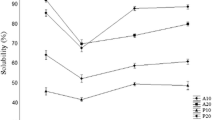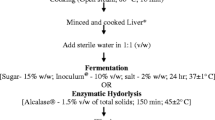Abstract
Fermentative protein hydrolysates (FPH) were prepared with a proteolytic bacterium, Bacillus strain exhibiting high proteolytic activity. Three FPH with 1, 2, and 4 % of cod protein hydrolysate (CPH) and 0.5 % of yeast extract in the culture were prepared. The yields achieved varied between 30 and 58 % based on protein content. A general decrease of leucine, isoleucine, valine, alanine, arginine, threonine, proline, and glutamic acid was observed. All FPHs showed higher reducing power and DPPH radical scavenging activity than CPH, but similar ABTS radical scavenging activity. However, FPHs exhibited lower Cu+2-chelating activity than CPH. The ACE inhibitory activity of FPHs was not improved relatively to that recorded in CPH. The fermentative process seems to have potential to obtaining hydrolysates with improved biological activities or even to produce protein hydrolysates from native fish proteins.






Similar content being viewed by others
References
Agyei, D., & Danquah, M. K. (2011). Industrial-scale manufacturing of pharmaceutical-grade bioactive peptides. Biotechnology Advances, 29, 272–277.
Venugopal, V. (1994). In fisheries processing: biotechnological applications., (Martin, A. M., ed.), Chapman & Hall,, London, UK, pp. 223-243.
Korhonen, H., & Pihlanto, A. (2006). Bioactive peptides: production and functionality. International Dairy Journal, 16, 945–960.
Martínez-Alvarez, O., Guimas, L., Delannoy, C., & Fouchereau-Peron, M. (2008). Use of a commercial protease and yeasts to obtain CGRP-like molecules from saithe protein. Journal of Agricultural and Food Chemistry, 56, 7853–7859.
Balakrishnan, B., Prasad, B., Rai, A., Velappan, S., Subbanna, M., & Narayan, B. (2011). In vitro antioxidant and antibacterial properties of hydrolysed proteins of delimed tannery fleshings: comparison of acid hydrolysis and fermentation methods. Biodegradation, 22, 287–295.
Fakhfakh, N., Ktari, N., Siala, R., & Nasri, M. (2013). Wool-waste valorization: production of protein hydrolysate with high antioxidative potential by fermentation with a new keratinolytic bacterium, Bacillus pumilus A1. Journal of Applied Microbiology, 115, 424–433.
Torino, M. I., Limón, R. I., Martínez-Villaluenga, C., Mäkinen, S., Pihlanto, A., Vidal-Valverde, C., & Frias, J. (2013). Antioxidant and antihypertensive properties of liquid and solid state fermented lentils. Food Chemistry, 136, 1030–1037.
Jemil, I., Jridi, M., Nasri, R., Ktari, N., Ben Slama-Ben Salem, R., Mehiri, M., Hajji, M., & Nasri, M. (2014). Functional, antioxidant and antibacterial properties of protein hydrolysates prepared from fish meat fermented by Bacillus subtilis A26. Process Biochemistry, 49, 963–972.
Twining, S. S. (1984). Fluorescein isothiocyanate-labeled casein assay for proteolytic enzymes. Analytical Biochemistry, 143, 30–34.
Saint-Denis, T., & Goupy, J. (2004). Optimization of a nitrogen analyser based on the Dumas method. Analytica Chimica Acta, 515, 191–198.
AOAC. (1998). Amino acids in feeds - AOAC official method 994.12 (16th ed.). Washington, DC: Association of Official Analytical Chemistry.
AOAC. (1998). Tryptophan in foods and food and feed ingredients - AOAC official method 988.15 (16th ed.). Washington, DC: Association of Official Analytical Chemistry.
Henderson, J. W., Ricker, R. D., Bidlingmeyer, B. A., & Woodward, C. (2000). Rapid, accurate, sensitive and reproducible analysis of amino acids. Palo Alto: Agilent Technologies.
Nielsen, P. M., Petersen, D., & Dambmann, C. (2001). Improved method for determining food protein degree of hydrolysis. Journal of Food Science, 66, 642–646.
Shimada, K., Fujikawa, K., Yahara, K., & Nakamura, T. (1992). Antioxidative properties of xanthan on the autoxidation of soybean oil in cyclodextrin emulsion. Journal of Agricultural and Food Chemistry, 40, 945–948.
Picot, L., Ravallec, R., Fouchereau-Péron, M., Vandanjon, L., Jaouen, P., Chaplain-Derouiniot, M., Guérard, F., Chabeaud, A., LeGal, Y., Alvarez, O. M., Bergé, J.-P., Piot, J.-M., Batista, I., Pires, C., Thorkelsson, G., Delannoy, C., Jakobsen, G., Johansson, I., & Bourseau, P. (2010). Impact of ultrafiltration and nanofiltration of an industrial fish protein hydrolysate on its bioactive properties. Journal of the Science of Food and Agriculture, 90, 1819–1826.
Re, R., Pellegrini, N., Proteggente, A., Pannala, A., Yang, M., & Rice-Evans, C. (1999). Antioxidant activity applying an improved ABTS radical cation decolorization assay. Free Radical Biology & Medicine, 26, 1231–1237.
Oyaizu, M. (1988). Antioxidative activities of browning products of glucosamine fractionated by organic solvent and thin-layer chromatography. Nippon Shokuhin Kogyo Gakkaishi, 35, 771–775.
Saiga, A., Tanabe, S., & Nishimura, T. (2003). Antioxidant activity of peptides obtained from porcine myofibrillar proteins by protease treatment. Journal of Agricultural and Food Chemistry, 51, 3661–3667.
Torres-Fuentes, C., Alaiz, M., & Vioque, J. (2011). Affinity purification and characterisation of chelating peptides from chickpea protein hydrolysates. Food Chemistry, 129, 485–490.
Decker, E. A., & Welch, B. (1990). Role of ferritin as a lipid oxidation catalyst in muscle food. Journal of Agricultural and Food Chemistry, 38, 674–677.
Geirsdottir, M., Sigurgisladottir, S., Hamaguchi, P. Y., Thorkelsson, G., Johannsson, R., Kristinsson, H. G., & Kristjansson, M. M. (2011). Enzymatic hydrolysis of blue whiting (Micromesistius poutassou); functional and bioactive properties. Journal of Food Science, 76, C14–C20.
Souissi, N., Ellouz-Triki, Y., Bougatef, A., Blibech, M., & Nasri, M. (2008). Preparation and use of media for protease-producing bacterial strains based on by-products from cuttlefish (Sepia officinalis) and wastewaters from marine-products processing factories. Microbiological Research, 163, 473–480.
Priest, F. G. (1977). Extracellular enzyme synthesis in the genus Bacillus. Bacteriological Reviews, 41, 711–753.
Razak, C. N. A., Tang, S. W., Basri, M., & Salleh, A. B. (1997). Preliminary study on the production of extracellular protease from a newly isolated Bacillus sp. (No.1) and the physical factors affecting its production. Pertanika Journal of Science & Technology, 5, 169–177.
Sousa, F., Jus, S., Erbel, A., Kokol, V., Cavaco-Paulo, A., & Gubitz, G. M. (2007). A novel metalloprotease from Bacillus cereus for protein fibre processing. Enzyme and Microbial Technology, 40, 1772–1781.
Cheng, S.-W., Wang, Y.-F., & Wang, M.-L. (2012). Statistical optimization of medium compositions for alkaline protease production by newly isolated Bacillus amyloliquefaciens. Chemical and Biochemical Engineering Quarterly, 26, 225–231.
Beg, Q. K., Sahai, V., & Gupta, R. (2003). Statistical media optimization and alkaline protease production from Bacillus mojavensis in a bioreactor. Process Biochemistry, 39, 203–209.
Fakhfakh, N., Ktari, N., Haddar, A., Mnif, I. H., Dahmen, I., & Nasri, M. (2011). Total solubilisation of the chicken feathers by fermentation with a keratinolytic bacterium, Bacillus pumilus A1, and the production of protein hydrolysate with high antioxidative activity. Process Biochemistry, 46, 1731–1737.
Kim, D.-O., Lee, K. W., Lee, H. J., & Lee, C. Y. (2002). Vitamin C equivalent antioxidant capacity (VCEAC) of phenolic phytochemicals. Journal of Agricultural and Food Chemistry, 50, 3713–3717.
Ovissipour, M., Abedian, A., Motamedzadegan, A., Rasco, B., Safari, R., & Shahiri, H. (2009). The effect of enzymatic hydrolysis time and temperature on the properties of protein hydrolysates from Persian sturgeon (Acipenser persicus) viscera. Food Chemistry, 115, 238–242.
Zhu, L., Chen, J., Tang, X., & Xiong, Y. L. (2008). Reducing, radical scavenging, and chelation properties of in vitro digests of alcalase-treated zein hydrolysate. Journal of Agricultural and Food Chemistry, 56, 2714–2721.
Carrasco-Castilla, J., Hernández-Álvarez, A. J., Jiménez-Martínez, C., Jacinto-Hernández, C., Alaiz, M., Girón-Calle, J., Vioque, J., & Dávila-Ortiz, G. (2012). Antioxidant and metal chelating activities of peptide fractions from phaseolin and bean protein hydrolysates. Food Chemistry, 135, 1789–1795.
Kong, B., & Xiong, Y. L. (2006). Antioxidant activity of zein hydrolysates in a liposome system and the possible mode of action. Journal of Agricultural and Food Chemistry, 54, 6059–6068.
Moat, A. G., Foster, J. W., Spector, M. P. (2003). in microbial physiology, John Wiley & Sons, Inc., pp. 475-502.
Cooper, G. M. (2000) The biosynthesis of cell constituent. In G. M. Cooper (Ed.), The cell: a molecular approach: 2nd edition. Sinauer Associates Inc, Boston University.
Acknowledgments
Bárbara Teixeira acknowledges the project SECUREFISH - “Improving Food Security by Reducing Post Harvest Losses in the Fisheries Sector” FP 7 EU PROJECT THEME: KBBE.2011.2.5-02 (Grant agreement No 289282) for supporting her grant.
Author information
Authors and Affiliations
Corresponding author
Rights and permissions
About this article
Cite this article
Godinho, I., Pires, C., Pedro, S. et al. Antioxidant Properties of Fish Protein Hydrolysates Prepared from Cod Protein Hydrolysate by Bacillus sp.. Appl Biochem Biotechnol 178, 1095–1112 (2016). https://doi.org/10.1007/s12010-015-1931-5
Received:
Accepted:
Published:
Issue Date:
DOI: https://doi.org/10.1007/s12010-015-1931-5




